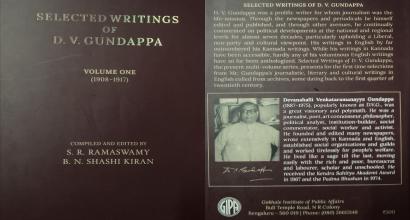Note: This is an English translation of DVG’s lecture delivered at All India Radio on May 10, 1957.
Culture is the elegance of beauty found in human relationships. It is the amalgamated light of one’s own nature and that of others. The root of culture relates to our Inner Lives. It is our intrinsic treasure. Its dwelling place is our mind and heart. That which is apart from this dwelling place is our external or worldly life. These are concrete things like house, vehicle, jewelry and money. In the last fifty years, our country has progressed quite impressively with respect to these external conveniences. Even in the recent past, motor vehicles and airplanes weren’t as common as they are now. Likewise, schools, hospitals, trains, banks, factories and businesses were not as widespread. We have witnessed growth in this external wealth. However, we have not grown proportionately in our Inner wealth during the same period. In my opinion, we have only grown poorer. My present purpose is to offer five or six instances that demonstrate this poverty.
First, machines are occupying the place of humans. We are cultivating a practice whereby machines are doing the work that should be performed by the human heart. Fifty years ago, wedding invitations were handwritten. Now they are printed. During the process of writing by hand, the mind would contemplate on the stature of each recipient and offer the appropriate affection and respect. That is what is known in English as the personal touch in the real sense. That is no longer the case now; the printed invitation card akin to newspapers, reaches a thousand people. It does not need the wisdom of discernment.
In the past, when guests and well-wishers visited home, the host would place homemade snacks. Now we buy stuff from hotels. Else, we take them to hotels. It may be true that hotel food is tastier. But will it contain the same heartfelt love and affection of family members who actually prepare the food with their own hands?
In the past, if there was a pregnant woman in the home, family members would prepare Chakkuli for her by weaving its circular folds by hand. Nowadays, it is rare to see these circular beauties. What used to be prepared by fingers is now being prepared by mortars. The heart operated behind the fingers. There is no intimate relationship between the mortar and the heart.
When the bridegroom sat on the wedding dais, young women would sing, motivated by pride in their melodic voices and old women would sing from the enthusiasm of affection. Today’s music is the gramophone.
The fragrance of those days emanated from a heady mix of sandalwood paste mixed with saffron and camphor, ground by hand. Today, it is “scent.” Artifice has replaced nature.
Let’s look at another point. In these last fifty years, our people have lost pride in workmanship. In the past, people had deep respect towards their daily chores – the man in his profession, the woman in her cooking and household work. The farmer had justified arrogance in the prowess of his plough, oxen and farming. The carpenter and the mason took enormous pride in the magic in their fingers. The accountant was proud of his elegant calligraphy, the Purohita took pride in the melodic accuracy of his mantra, the schoolteacher in the purity of his teaching, and the potter beamed with joy at the suppleness of his hands. In those days, the feeling that work must be done solely for the sake of wages was not all that prevalent. It is not that they did not need money for their work. Some of these people were poor. However, they had not learnt the practice of deliberately deceiving via their professions. Their mind would not accept even the notion of cutting corners while carrying out professional duties. The conviction of the people of that era was that the food that they ate without doing honest work would not digest. This was an article of discipline among them: just as how nature discharges her duty, we too must perform our duty with as much skill and beauty as possible. Working in an unseemly hurry, cutting corners, displaying an outward pretence of hard labour, and trying to extract maximum money for minimal effort—these attitudes were unknown back then. Of late, new businesses and professions have sprung up and have instilled a mentality of leading a crafty life. The ways of the city life, hypocrisy, and easy access to deceptive advertising have enfeebled genuine integrity and encouraged guile and duplicitous methods. In this manner, even the minimum qualification for work is reducing in our people at an alarming pace. There is no greater loss for a society than the loss of workmanship.
Now let’s consider another topic. This relates to the sundering of the family. Fifty years ago, it was not uncommon to see families that comprised about twenty or twenty-five people living under the same roof. This included three or four brothers, their wives and children, grandchildren, sisters, sisters-in-law, and relatives who had lost their homes. I have myself witnessed several families consisting of more than a hundred people living together. These joint families lived under the leadership of a single man. Neither were these families bereft of difficulties. Those difficulties have not gone away today either. However, the nature of the present difficulties is different. The roots of trouble and conflict exist in human nature itself. In those days, there were time-tested methods to resolve these conflicts and troubles. In essence, it was a system of preserving unity. It was a form of democracy—government of the people in the real sense. A life of togetherness. Of late, that feeling of oneness has melted away and the feeling of individuality is gaining strength. To each his own: this is the dominant current. The strong gets to sit on the terrace. The weak gets the ditch. In this manner, the house that was one is now being divided into multiple portions.
Thus, we have a two-faced government in the same home. This phenomenon shows itself very clearly in the wedding invitation cards in recent times. Twenty-five years ago, the invitation to an auspicious function at our home was sent out only in my father’s name. Because it was assumed that my name was also included in the invite, some of my friends, unacquainted with my father, also showed up for the function. Among them was an elderly gentleman. He was eminent in every sense. He disembarked from the car and I greeted him warmly. He said, “Please go to the car. There’s another person you might want to meet.” It was his wife. She also knew me. I greeted her, “Please, please come.” She smiled and said, “But women were not invited!” I said: “My mother is always present with my father. And we children should all be present wherever they are. My father has sent the invitation on behalf of our entire family to your entire family.” When she heard this, she said, “You are from an old era.” Then she stepped into our home, blessed us and left.
Today, the invitation from the husband and the invitation from the wife are separate. This new etiquette is a blind imitation of the Europeans. In that system, there is no sign of the essential unity of the husband and wife. There is every sign of separate, individual personalities. It is supposedly a great marker of male-female equality! In which case, why should the woman accept the Gotra of the husband? Why should she take cover behind his name? Instead of using the address, Mrs. and Mr. Ramanna, why can’t Mr. and Mrs. Sitamma be used? The word “couple” (dampati) is used in the singular: meaning, the wife has merged and become one with the husband and vice versa. This was the sentiment of our ancients.
To be continued









































